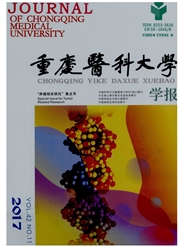

 中文摘要:
中文摘要:
目的:通过探索新疆地区肾癌患者与健康者之间血清蛋白表达谱的变化,筛选并建立新疆地区肾癌血清标志物诊断模型。方法:采用表面增强激光解吸离子化飞行时间质谱技术和弱阳离子交换蛋白芯片(CM10)对新疆地区44例健康对照与40例肾癌患者血清蛋白表达谱进行检测分析。结果:相比于健康对照组血清蛋白质荷比(mass to charge ratio,M/Z)峰值图谱,肾癌组表现出明显差异。其中10个差异性最大的蛋白(P〈0.05),均在健康对照组中低表达,而在肾癌组呈高表达,质荷比分别为5 914、5 940、8 087、8 155、5 949、8 067、5 986、5 346、15 946、6 116。建立的诊断模型是由10个蛋白(M/Z分别为:5 914、5 940、8 087、8 155、5 949、8 067、5 986、5 346、15 946、6 116)构成。应用十倍交叉留一法进行验证,结果此诊断模型的敏感度为92.50%(37/40),特异度为93.18%(41/44)。结论:将表面增强激光解吸电离飞行时间质谱技术以及生物信息学分析软件的联合运用是找到肾癌肿瘤标志物的一种有效的方法,建立的诊断模型能够较准确灵敏的区分健康对照与肾癌人群。其中M/Z 5 914、5 940、8 067、6 116对应的蛋白质可能为β-淀粉样蛋白、人体β-防御素、胃泌素释放前体肽以及金属硫蛋白。
 英文摘要:
英文摘要:
Objective:To explore changes in serum protein expression between patients with renal carcinoma and the healthy people so as to screen out and construct diagnostic model of renal carcinoma in Xinjiang. Methods:Weak cation exchange and hydrophobic surface protein chip(CM10)and surface-enhanced laser desorption ionization time of flight mass spectrometry(SELDI-TOF-MS)were used to detect the serum protein. Serum specimens from 40 renal carcinoma patients and 44 healthy controls were analyzed in order to screen out the serum differentially expressing proteins of renal carcinoma and to construct renal carcinoma diagnostic model.Results:Significantly differences were existed between healthy controls and renal carcinoma patients with renal carcinoma(P<0.05).Total ten protein peaks(mass to charge ratio(M/Z)being 5 914,5 940,8 087,8 155,5 949,8 067,5 986,5 346,15 946 and 6 116)were all high-expressed in patients with renal carcinoma and all of them were low-expressed in healthy controls. After cross validation,diagnostic model was composed and established by the above ten proteins. Specificity and sensitivity were 93.18%(41/44)and 92.50%(37/40). Conclusion:Bioinformatics software analysis combined with SELDI-TOF-MS is effective in looking for biomarkers of renal carcinoma. Patients with renal carcinoma and healthy controls in Xinjaing can be accurately distinguished by constitutive sensitive diagnostic model. Four(M/Z 5 914,5 940,8 067,6 116)protein peaks may be β-amyloid protein,human β-defensin,ProGRP and metallothionein.
 同期刊论文项目
同期刊论文项目
 同项目期刊论文
同项目期刊论文
 期刊信息
期刊信息
